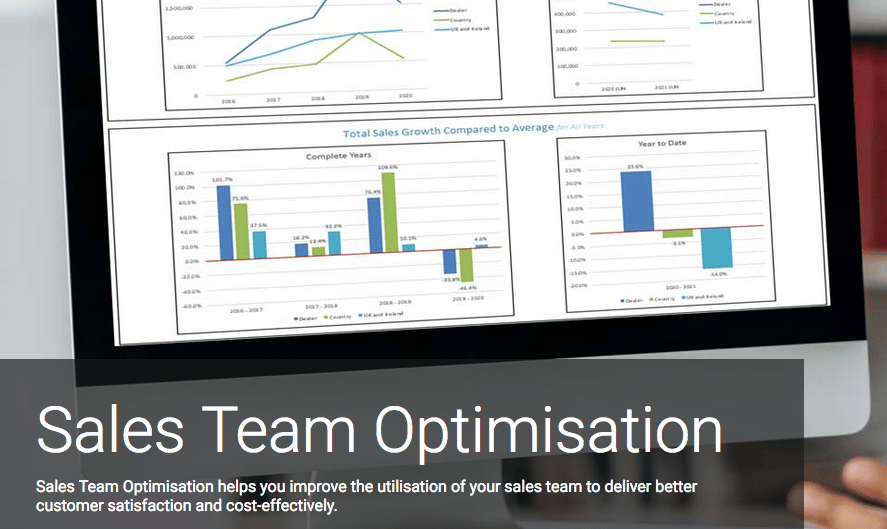If your business has the wrong number of salespeople, it’s likely you’re not optimising your sales potential. We’re going to explain how to get it right.
The importance of team structure
Before considering the correct size for your sales team, you must first think about the whole sales team structure. How we do business is changing, and with the advent of Zoom meetings and Microsoft Teams there may be less need for a traditional sales visit. This may mean you need to structure your sales team very differently, taking into account the various roles in your team and who does what.
Consider who is responsible for web meetings and online presentations to prospects and customers, who provides specialist product knowledge, who delivers training on new products or services, who provides help at exhibitions, and who is responsible for telemarketing, appointment making or creating presentations to aid sales pitches.
It’s vital to understand all of the internal resources and roles that may be involved in the sales process so that this can be factored into workload calculations later on in the sales team sizing process.
The right size sales team
Team size will largely depend on the sales goals the company has, but the first thing to understand is that having too few salespeople involved in selling your products or services means they will be too stretched to maximise sales opportunities.
Despite working hard, they may find it impossible to effectively cover all the prospects and customers allocated to their sales territory or visit (when needed) all the potential customers who may be interested in what you offer. This means sales, and profits, are missed.
But having too large a team can be equally as bad. Their costs will eat into your profits and if their roles are not clearly defined, they may end up competing with one another for the same customers. This is clearly a waste of resources and is highly inefficient.
However, knowing what size sales team to have can be challenging. There are numerous factors to consider and many different business objectives – from ensuring the sales team hit targets to wanting to reduce costs (amongst many more).
Sadly, many companies rely on gut instinct and guesswork to decide how many people are needed in the team, but this is rarely the most effective way to work.
Instead, the decision needs to be based on data and evidence and a thorough understanding of the market and customers.
Based on our experience, we know defining exactly the right size sales team structure relies upon deep analysis of the following factors:
Industry sector
Which sector does the company work in and does it sell directly to consumers (B2C) or to other businesses (B2B)? This dictates the approach to be taken, specific to each company and their market.
Strategic objectives
Are company sales objectives realistic and achievable and are sales quotas based on thorough workload calculations and a robust sales strategy?
Does the business correctly segment customers and ensure the best, most cost-effective approaches are taken to keep in touch and liaise with them? This may involve different departments and functions within a business, from marketing to technical specialists.
Target audience and products
What are the product or service types, volumes purchased, and order values?
What are the customer buying patterns and how easy is it to identify high, medium, or low value customers?
Are customers accurately segmented by type and purchase history, including identifying those that are inactive or lapsed (lapsed customers – typically defined as not having bought for 12 months – are often ‘low-hanging fruit’ for sales teams)?
What products are frequently bought together and are there unexploited cross-selling and up-selling opportunities for the business?
What sales channels and marketing has proved to be the most effective and could some customers be managed differently, for example, by a telemarketing team or through emails instead of expensive sales visits?
Sales territories
Are sales territories based on data or were they created to follow simple geographic boundaries such as county or state lines?
Do each of them offer the same opportunities to sales staff, or if not, what factors are used for differentiation?
Forecasting
Has the future value of each customer been analysed based on their past sales history, purchase frequency, recency of last purchase and value?
Are the right level and type of sales resources assigned to customers based on their forecasted value to the company?
Segmentation
Does the sales strategy follow the customer segmentation analysis so that those customers that have the most value to the company receive the right level of contact?
Distributor networks
Are distributors used to supply retail stockists, dealers, and/or end customers? If so, where are they located geographically and where are their customers?
Are there gaps in the geographic coverage?
Personnel
What is the current sales team structure and size, and do they effectively cover all target territories and maximise opportunities?
Is there competition amongst the team for the same customers and/or do they infringe on one another’s areas?
Is specialist knowledge or skill required for some sales?
Is there an internal telesales team or could an in-house or outsourced team be used to liaise with lower value (but still important) customers?
Is there any internal sales support or admin team who can manage things like appointments and follow-ups?
How do all the related teams work together to optimise the sales process?
Analysis of all these factors, plus many more, leads to robust data-driven recommendations on how to maximise sales with exactly the right number of sales staff.
So if you want to ensure your business has the optimum number of salespeople and your sales strategy is intelligence-led, talk to Tech4T today.

